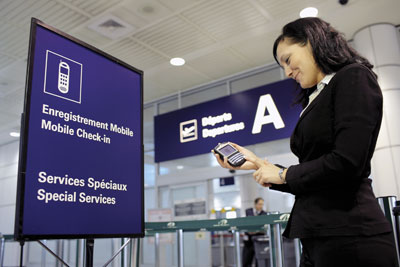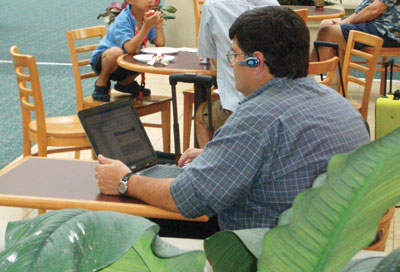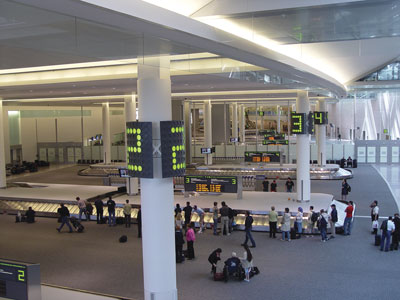
Features
Send Me a Kiss by Wire(less)
The term enabling technology could have been tailor-made for airport wireless communication systems.
July 28, 2009 By Carroll McCormick
The term enabling technology could have been tailor-made for airport wireless communication systems. The uses to which they can be put seem limited only by the imagination and airport budgets: cellphone calls, Internet access, passenger check-in, random security checks, access to translation services, baggage reconciliation, mobile staff workstations, data transfer with aircraft, flight information display systems … all unfettered, as long as the users are within the range of wireless antennae.
 |
|
| Wireless transmission of boarding passes is convenient and paper-free. |
Innovative airports like Vancouver and Trudeau have pushed the applications of their wireless networks the furthest, and passengers are the big beneficiaries. In 2000 Vancouver became the first airport in North America to offer wireless Internet access via communications provider Nokia. Last Nov. 1, Vancouver became the first major Canadian airport to offer free wireless access to the Internet throughout the whole airport, in both pre- and post-security areas and in all terminal buildings, according to Grant Fengstad, the airport’s manager, technology planning.
Wi-fi, as this wireless Internet access is called, can be free or for-fee. The Calgary airport also moved to a free access model just before last Christmas. Some airports, such as Pearson, Trudeau, Charlottetown and Abbotsford, offer a fee-based service, or service for passengers via their existing subscriptions with hotspot providers such as Aliant, Boingo or Bell. Fee, free and by whom all depends on the airport and its revenue philosophy. Calgary decided that the added value of quick and easy passenger access was worth forgoing revenues and absorbing the added cost: “We had a lot of requests from passengers to have free access. We are always interested in enhancing the passenger experience and expect to pick up some revenues with our revised model. The customers experienced some frustration with the original hotspot log-in process. Some users said it wasn’t worth the bother for the few minutes they wanted to use it. We have seen a ten-fold growth in the public Wi-fi usage since we went to the free environment,” explains Paul Lawrence, director of information technology and telecommunications with the Calgary Airport Authority.
 |
|
| Passengers love free Internet access. |
Wireless systems that are not owned by the host airports are common in North America. Big airports, like Trudeau, whose Wi-fi system was deployed by, and is operated by Bell, have them too, but they are particularly convenient for airports too small to justify having their own IT departments. Opti-Fi, now owned by Boingo, installed its own turnkey system at the Abbotsford airport in 2004, and operates and maintains it under a pay-for-use model. It covers the terminal and the trade and convention centre on the airport property.
Abbotsford is considering going to a hybrid free/fee access model. “We would like to go to free Internet. We are looking to move to 15 minutes free, and then if you want more time than that, you would pay for it. You would also see advertising,” says Parm Sidhu, the airport business development manager and operations manager. Staff at the airport have little occasion to use the system, but, Sidhu notes, “We occasionally use Wi-fi for presentations at meetings when someone does not have a land line for Internet access.”
The comment about advertising refers to a way of generating advertising revenues from the “splash page,” which is the first web page passengers splash down on, as one metaphor-enabled IT manager explained. Some splash pages just have airport logos and some information, others have ads. For example, Vancouver currently does not offer advertising opportunities, but the greater Toronto Airports Authority (GTAA) earns revenues from splash page advertising and user fees. A splash page, typically the airport’s home page, is also a place where passengers can access flight information and, at hipper airports, inner-city happenings.
 |
|
| Wireless systems permit baggage reconciliation. |
Ottawa-based BOLDstreet, which bills itself as Canada’s leading provider of public Wi-fi solutions, is helping Calgary develop a revenue model and provide some of the services (for the public side) needed to manage access and customer questions. BOLDstreet helped Calgary develop the interface page and put up the links to Facebook and the Internet One might expect regular old cellphones to work anywhere at any airport, given the reasonable assumption that they must be technology meccas. Some do have ubiquitous access, but at Pearson, for example, this ubiquity is an earned privilege for cell providers, so not all passengers’ cellphones have complete coverage there. Having decided that passengers should have excellent coverage, GTAA gave cellular providers a choice: use the airport antennae system and provide excellent service, or offer coverage from off-airport equipment and provide “best effort service.” “It was a corporate position that if a cellular provider was to be allowed to have a cell site on our property, they would have to give customers ubiquitous coverage,” explains Thomas Tisch, GTAA’s director of information technologies and telecommunications operations. Bell agreed to use our antennae system and provides excellent service. Telus and Rogers chose not to.”
Cellphones keep passengers busy, jacked in or amused, but airports like Trudeau are using the technology to smooth passengers’ transit through the airport. It allows more effective use of terminal space and enables paperless ticketing. The most advanced scenario, in use now, has passengers checking in remotely using personal digital assistants (PDA) or mobile phones. The airlines, most notably Air Canada, send unique 2D bar codes, which serve as boarding passes, to the passengers’ PDA. Passengers pull up the codes on their PDAs at the security checkpoints, where Canadian Air Transport Security Authority staff decode and read them. If the data matches the passengers, they are whisked through.
Other airlines offer lesser versions of this scenario; e.g., checking in at home on the Internet and receiving the 2D bar codes on PDA. A variation on the theme of accessing flight information with cellphones is called short message service (SMS). Trudeau has been using SMS for close to two years to get flight information to cellphones or PDAs. Briefly explained, this fee-for-use service lets people receive flight status and updates. Antoine Rostworowski, director of product development at Trudeau, gives an example: “If you want information on flight AY123 arriving from Calgary, say, text ‘’AY123’’ to the number 23636. One you have received your flight status, the system will ask you if you would like to receive an alert of change if the schedule changes.”
Common use self-serve
kiosks (CUSSK) at Trudeau can read 2D bar codes off PDAs, and then print out boarding passes and baggage tags. Speaking of CUSSK, airports are also quite capable of establishing wireless links to them, which allow them to be easily relocated to suit their changing needs. “We are looking at wireless CUSSK. We would like to deploy them for certain cases,” Rostworowski says.
Wi-Fi is the enabler of speedy baggage reconciliation – the practice of matching each piece of luggage with its owner before it is packed on the plane. Here is how it works. As baggage works its way through the baggage handling system, the baggage tags are scanned at various points. At the boarding gates, agents use barcode scanners to confirm passengers’ flight records and board the passengers in the Departure Control System (DCS). The Departure Control System is linked to the Baggage Reconciliation System (BRS), and each passenger’s status will generate a load/not load message for her baggage. The agents working in the baggage room use wireless handheld scanners to scan each bag tag, and BRS indicates whether the bag should be loaded. Bags belonging to passengers who do not board the flight are not loaded in the airplane.
Airport staff use Wi-Fi for many other uses, although the degree to which Wi-Fi-enabled staff communication is found depends on factors like the size and IT budget of the airport and recent enlightening events. For example, after our RCMP Tasered distraught and unarmed Robert Dziekanski to death in October 2007, the Vancouver Airport Authority implemented many changes, some of which are enabled by wireless communications: “On Dec. 7, 2007 we announced a number of changes to customer care. Included in those changes was providing mobile communications devices (BlackBerrys) to customer care representatives in the customs hall. The devices provide access to a 24-hour language line, which offers translation services in more than 170 languages. In addition to providing access to these translation services, the devices may also be used to phone a passenger’s party in the public greeting area to let them know the passenger has arrived,” Fengstad explains.
Customer care representatives can receive e-mailed situation reports instantly on their mobile device rather than waiting until they get to their computers. “The addition of Wi-Fi throughout our terminal buildings allows operations staff to access the intranet and share information from wherever they are,” Fengstad adds.
Car rental companies have also turned onto Wi-Fi. “The biggest non-passenger users of Wi-Fi at Pearson are the car rental companies, Tisch says. “Someone with a handheld unit collects information like mileage and gas. When the renter comes back the handheld unit obtains miles driven and gas left in the tank. This is all done with Wi-Fi.”
The sky would seem to be the limit for the uses for wireless networks, but even that may be shooting low. Global communications, engineering and integrations provider ARINC is poised to launch the next huge airport wireless application, called GateFusion. Officially launched in June 2007, GateFusion allows large data transfers between planes at the gate and their ground applications. ARINC developed GateFusion to provide wireless data transfer services for e-enabled aircraft at airport gates around the world.
“One of the key drivers of the service is the B-787, whose sophisticated avionics and applications require a gate link solution. The A-380 is also coming equipped with Wi-Fi capability requiring gate link connectivity. GateFusion supports large and small data transfers between these planes and their ground applications. Additionally, other applications such as in-flight entertainment and electronic flight bags are driving the retrofit of Wi-Fi avionics on existing fleets,” explains Mike Dufton, sales director for commercial aviation solutions, ARINC.
“The 787 requires plane-ground-plane data transfer. Manuals, parts and applications updates are handled by the new wireless requirements. As a result, these aircraft are coming with Wi-Fi capability, but Boeing is not supplying the network solution for these updates. We are providing the common-use ground communications infrastructure,” Dufton adds. “Today, airlines are using various “sneakernet” update solutions, including disks, drives, and thumb drives to load and unload data from aircraft. GateFusion automates this process.”
ARINC installs GateFusion servers at airports along with connectivity to its global network, which has connections to most of the world’s airlines. In most cases, ARINC becomes a customer of the airport for Wi-Fi on the ramp. ARINC has operating systems installed in Orlando, Fla., and Manchester, England, primarily for test and demonstration purposes with various airlines. Hong Kong is scheduled for installation later this year. GateFusion is currently not operating in Canada, but ARINC has been setting the stage by negotiating early with Wi-Fi service providers. For example, it has agreements in place to install GateFusion at Pearson with 90 days’ notice. Trudeau and Vancouver are the two other big candidates in Canada.